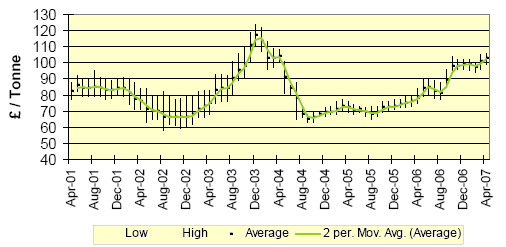



British Milk – What Price 2007?
By the National Farmers’ Union and Royal Association of British Dairy Farmers, NFU, NADF. Latest British milk report.
Introduction
The NFU and RABDF have once again joined forces to produce an update to the ‘British Milk - What Price?’ series of reports, examining developments of production costs and other market related factors.
In the last twelve months, ‘British Milk – What Price 2006?’ has been used extensively in commercial discussions with processors, milk buyers and retailers, as well as being utilised as a benchmark by many producers. Many consider the report to have directly contributed to the recent milk price developments that have benefited some milk producers.
This latest report provides an appraisal of:
- Increases in farm costs of production
- Regulatory pressures
- The market context
- The impact of modulation on SPS receipts by dairy farmers
- Milk production and farmer intentions
- Re-investment levels
1) Increases in farm costs of production
In order to assess the cost of milk production in 2006/07, we have based our calculations on the 2002/03 data from the ‘Economics of Milk Production Survey 2002/03’ report (Colman, Farrar and Zhuang) by the University of Manchester (which is widely regarded by industry, retailers and government as the most robust data set available). Independent and reputable agricultural indices from the past four milk years have been applied to the original figures, with the detailed results shown on Page 5 of this report.
It should be pointed out that the analysis does not take account of potential increases in farmer efficiency that may have occurred over the same time period, which might have mitigated, to some extent, some of the impact of these cost increases.
Labour costs
Labour costs have continued to rise over the last milk year. Specific Labour and Overhead Other Employed Labour have been costed at Agricultural Wages Board (AWB) Grade 1 rates and have increased by 16.11% between 2002/03 and 2006/07. Forage Labour which has been costed at AWB Craft Worker, rates has increased by 16.38%. Casual Labour has been costed at AWB Grade 2 rates, and has risen by 16.94%. The cost of unpaid family labour has been included in the figures.
The continuing rises in labour costs enforced by the AWB are proving difficult for many dairy farmers to cover. Acquiring skilled and experienced dairy labour is also becoming harder year on year and is expected to become increasingly difficult, as higher minimum statutory rates for students make additional labour unaffordable for dairy farmers, resulting in
less students being provided with the opportunities to gain essential work experience on dairy farms. This might have major implications for the future of the industry.
Utility costs
Over recent years there have been dramatic increases in energy costs, and the 2006/07 milk year has been no exception. This has not only caused general farm overheads to rise by 19.32% since the 2002/03 milk year, but has resulted in further cost increases, as rises in costs such as fuel have knock-on effects on other types of expenditure, including contractor charges, feed costs and herd replacement costs.
In September 2006, NFU and RABDF carried out a survey into the exceptional production costs farmers were facing at the time. One of the areas investigated was the additional financial burdens resulting from higher energy and other utility charges. The study proved that large numbers of milk producers have faced marked increases in the main utility bills (fuels, electricity and water) for their businesses. With farmgate milk prices consistently remaining lower than production costs, producers have not been in a position to absorb these additional costs.
Feed costs
Since 2002/03, feed costs have fluctuated year on year as highlighted by the feed wheat graph below. The variation in feed costs over the last four milk years has largely been determined by weather conditions, although in future there might be other factors that may potentially increase the volatility of grain prices, such as the implications of bio-fuel production. During the 2006/07 milk year, firmer cereal prices caused feed costs to rise. Because expenditure on feed is one of the major costs of production, this had serious implications on dairy farm profitability. It is anticipated that feed costs will continue to escalate over the next year.

Source: MDC Datum
In addition to higher feed prices in the last milk year, farmers have also had to cover additional unexpected costs brought about by last summer’s dry weather. Many dairy farmers were forced to feed home-grown forage early in an attempt to mitigate yield losses. Consequently, they then had to buy in supplementary feed stuffs to fulfil their winter feed requirements. These costs were investigated in the Exceptional Costs Survey referred to in the utility cost section on the previous page. Due to the methodology of the ‘British Milk – What Price?’ work, the exceptional costs farmers had to contend with during 2006/07 have not been incorporated into the costs of milk production figures laid out in this report, and therefore must be considered in addition over and above the figures stated.
Interest charges
Interest charges were not included in the Economics of Milk Production Survey 2002/03. However, interest charges are becoming an increasingly significant cost for farmers in general - The Bank of England recently released figures stating that at the end of December 2006, the total farming debt in the UK stood at £9.375 billion. Dairy farmers partake in these high levels of debt, with many having to borrow money to remain in production and/or undertake necessary investment.
In order to quantify an average interest charge for dairy enterprises, we have used DEFRA data from the “Farm Business Survey for England, 2005/06” (FBS, 2005/06), updating it to allow for the increase in interest rates that has taken place since then.¹ Assuming that the level of debt has remained constant (a fairly cautious assumption, taking into account the growing financial pressure faced by dairy farmers) and that the increase in the Bank of England’s official rate has been fully transmitted to dairy farmers, our estimates show that the average dairy farmer in England is facing net interest rate payments equivalent to 0.8 ppl.²
Overall cost increase
The table on Page 5 of this report documents the changes in the costs of milk production between 2002/03 and 2006/07 and demonstrates a 16.43% increase overall. These figures do not account for exceptional costs incurred and do not provide scope for re-investment (which is essential for the future viability of the dairy sector). They also do not allow for increases in farmer efficiency that may have occurred over the four-year period in question.
According to DEFRA, the average farmgate milk price from April 2006 to February 2007 (March 2007 figures are yet to be released) was 17.90ppl, whilst our calculations show (accepting the caveats previously mentioned) the average cost of production was 21.32ppl. Our estimates highlight that the deficit between the farmgate milk price and the cost of production has extended to nearly 3.5ppl and it is anticipated that even recent price increases will have little impact on this gap.
²The average level of net interest rate payments is allocated on a ‘per litre’ basis by using data on average production per English farmer, obtained from MDC data on English production and number of English producers.
To view the rest of the report, click here.
April 2007


